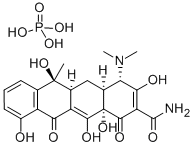Manufacturing Process
In a 500-ml round-bottomed flask equipped with stirrer, condenser and
thermometer was placed 7.1 grams (0.05 mol) P2O5 which was immediately
covered with 100 ml of chloroform. To the mixture was added with stirring 0.9
ml (0.05 mol) of distilled water. In a few minutes, a lower oily layer appeared,
which was believed to be freshly formed metaphosphoric acid resulting from
the action of the P2O5 with an equimolar amount of water. To this mixture was
added 100 ml of methanol and on continued stirring, the lower oily layer
disappeared in the methanol forming a complete pale yellowish-green colored
solution.
An additional 50 ml of methanol was added to the flask and then 22.2 grams
(0.05 mol) of tetracycline, neutral form, was added portionwise intermittently
with another 50 ml of methanol. A clear solution was maintained throughout
the addition of the tetracycline. After addition of all of the tetracycline, the
solution was a deep orange color and the temperature in the reaction flask
was 35°C.
One hour after addition of the tetracycline, the clear reaction solution was
poured into 1,500 ml of chloroform. A yellow product separated and was
collected on a coarse sintered glass filter and air dried. The tetracyclinemetaphosphoric
acid complex weighed about 10 grams, contained 7.34% of
phosphorus and had a bioassay of 634 gammas per milligram. Solubility in
water is 750 mg/ml.

